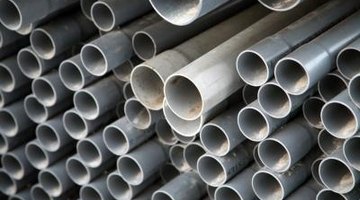What Kind of Supply Piping for a Propane Furnace?
Supply pipes run gas, water or oil from a storage tank into a home or business. The kinds of pipe vary significantly and not all can be safely used for every kind of fluid or gas. Propane tanks require black iron, copper or PVC pipes to safely transport propane from a tank to a residence or business.
Supply Lines

Propane tanks contain highly pressurized gas that must be regulated on its way from the tank to the home or residence. Upon exiting the tank, propane gas flows into the first stage regulator. This mechanism lowers the gas pressure but still retains enough to allow the gas to flow into the supply pipe. Supply pipe size has an impact on the amount of pressure the gas receives. The smaller the pipe's diameter, the higher the pressure. Propane supply pipes usually measure between 1 and 1/2 inch in diameter. The exact diameter is determined by the flow rate needed to power the furnace, the size of the tank, the distance from the tank to the furnace and the pressure within the tank itself. These measurements are best determined by professional contractors. Improper sizing of gas lines can be dangerous and explosive. Once the gas passes the first stage regulator, it travels from the area near the tank down the supply toward the furnace. Before entering and igniting the furnace, the gas passes through the secondary regulator where the pressure is again adjusted.
Copper and Black Iron Pipe
Copper or black iron pipe is used to transfer propane gas from its storage tank to the first regulator. These types of pipe are noncorrosive, nonflammable and capable of containing high pressure. Additional copper or black iron piping is used to complete the supply line, from first regulator to second regulator to furnace. The pipe can be used both above ground or underground.
PVC
Heavy duty PVC piping is also capable of safely transferring propane gas from the first regulator to the second regulator and into the furnace. PVC piping, however, isn't recommended for placement directly from the tank to the first regulator. Other precautions to take with PVC piping include laying the pipe underground and marking the pipe's area for above ground viewing. Flags or other markers can be used to demarcate the pipe's position. These location markings are important for future maintenance work and also serve as a warning to people wishing to dig around the area or place obstructions above the line.
Considerations
Propane takes the form of a liquid as well as a gas. At temperatures 44 degrees below zero Fahrenheit, the gas turns to liquid. In the liquid state, the gas is not able to ignite furnaces or appliances. In extreme weather, such as that found in Alaska, propane lines and tanks must be well-insulated. Lines and tanks can be loosely piled in snow. Special propane line heat tape also works to keep lines warm.
References
Writer Bio
Catherine Duffy's writing can be found on gardening blogs, tech sites and business blogs. Although these topics seem quite different, they have one area in common: systems and design. Duffy makes systems and design (as they pertains to plants, supply chains or software) entertaining and welcoming to general readers.
Photo Credits
- Jupiterimages/Photos.com/Getty Images
More Articles



